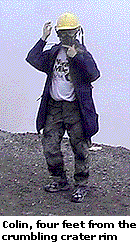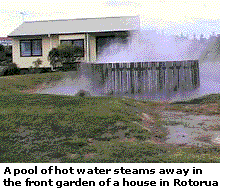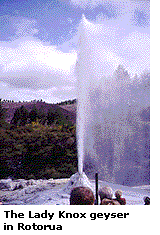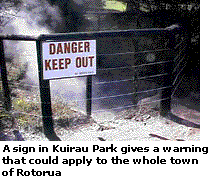 |
My Journey to White Island and Rotorua |
 |
|||
| White Island Volcano A black rubber gas mask covered my face and a yellow safety helmet was on my head. Steam and poisonous sulfur dioxide gas billowed up from the vast crater that was before me. A roaring and rumbling sound, like the growl of a living creature, came from beneath the ground. I stood four feet from the crumbling crater rim of gray ash, with black mud gushing up way below. I was at White Island, in the active heart of a living volcano. White Island (named by Captain Cook in 1769) is the one of two visible marine volcanoes off of New Zealand, but there are at least ten other volcanoes in the area below the sea. Within the crater are the crumbling ruins of a sulfur mining factory. The ruins are a ghostly, desolate place; gray, crumbling concrete walls reinforced with iron are all that remain. The iron is almost eaten away by acidic gas and ash from the volcano. Acid in the steam stung my eyes and throat. The gas mask was the only way to avoid the poisonous fumes. I thought how terrible it must have been to have lived and worked there. Dotted around the crater are white plastic tubes on sticks. These are magnetometers: machines that measure the earth's magnetic field. When molten rock comes to the surface, the magnetic field decreases, warning scientists that the volcano will have a large eruption. High on the crater rim are devices called seismographs which measure tremors of the earth; a moving pen traces a line on paper and shows when the earth shakes. Walking through the crater was like being on another planet. Erosion had worn gullies in the gray and red ash. The ash and the crater wall are scattered with rocks and yellow patches of sulfur. Clouds of billowing steam surround the area. Yet even on the volcano there was life. Little fleshy green plants, called iceplants, and pohutakawa trees were dotted around the outside of the crater. Some of the trees had been set on fire by burning ash and were just twisted black stumps. Birds nested on the edge of the volcano and in the sea off the island, a blue flying fish glided effortlessly through the air. Climbing back on the boat to return to the mainland, I breathed the fresh air and was glad to be heading back to land that was not so unpredictable and strangely alive — or so I thought.
Rotorua "The earthquakes today had me worried all right. The lampshades were swinging and you could see the walls moving. My youngest daughter started crying. You get used to it, though. More people have died from traffic accidents round here than in earthquakes and volcanic eruptions." After we talked, I cooked dinner on a steam oven, wrapping steak and vegetables in aluminum foil and letting it steam for two hours over a [volcanic] vent in the ground. As I was about to eat, the table moved in my cabin. A glass of water shook, then the walls swayed for several seconds. I smiled. In the same day I had been inside a volcano and experienced an earthquake — 4.9 on the Richter Scale. At Rotorua, a ring of mountains, 42 km around, surrounds a group of lakes. Tree ferns and native vegetation cover the ridge of hills to the west called the Mamakus. I had walked over these hills in the dark, with possums making strange noises in the black forest, mist covering everything. The Rotorua area was blown apart by a volcanic eruption over 140,000 years ago. The mountains here collapsed to form a huge depression, or caldera, in which Lake Rotorua now sits. The eruption was not the end of the story, though: the area is still volcanically active. At Whakarewarewa (Faka-raywa-raywa), bubbling pools of mud lie among manuka bush (plants called tea trees), ferns, clubmoss and blue-green algae. Waiotapu lies south of Rotorua and has colored lakes of hot water. There are shallow lakes of yellow and green waters colored by sulfur. Champagne Pool, a bubbling blue lake that's around 50 degrees C, has an orange rim formed by compounds containing the metal antimony. Near here is the Lady Knox geyser, which can shoot water 20 meters into the air. In 1886, a series of volcanic eruptions along Mount Tarawera blasted a huge gash in the land and buried a village in hot rock and ash, killing over 100 people. About 70,000 people live around Rotorua. The Maori people of the Te Arawa tribe have lived here for over 600 years. Early European settlers came to Rotorua to soak in its mineral pools. Since the 1860s, the town has grown as a tourist resort. As I walked to the lakeside Maori village of Ohinemutu, I got talking to a Maori lady called Mary. She took me to the family "oven." Coarsely woven bags lay in a pool of steaming water. Within the bags were kumara (sweet potato), greens, potatoes, and meat. To the Te Arawa, the hot water was a blessing from the gods. Mary also showed me to her family bathhouse. Laughing and splashing could be heard inside. As Mary opened the door, several young boys looked up with surprise. Mary told them not to make a mess and they respectfully nodded to her. The local Maori people bathe morning and night in the hot mineral waters. With all the benefits of constant hot water, the people of Rotorua have become accustomed to the shaking, bubbling, and hissing ground. To them Rotorua is just the place they call home. |

|
||||
|
|||||




